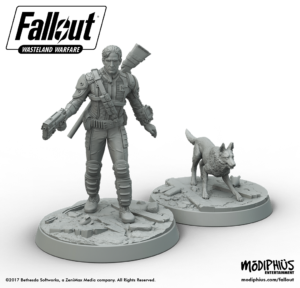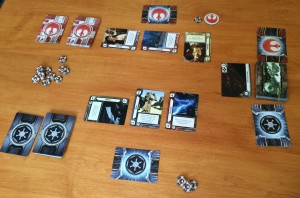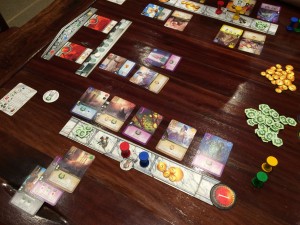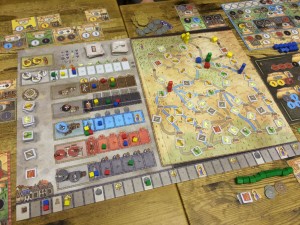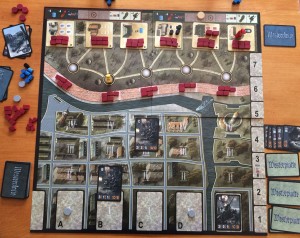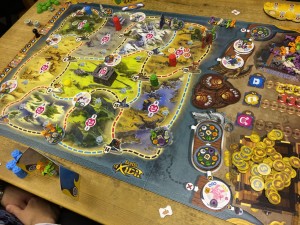Fallout: Wasteland Warfare – Development Blog 5: Leaders and Heroic
Posted by James (admin) on 14th September 2017
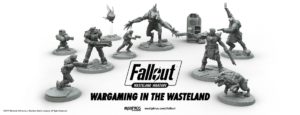 In this development blog about Fallout: Wasteland Warfare game from Modiphius, we shall look at Armour and Leaders (which were mentioned in the previous development blog post).
In this development blog about Fallout: Wasteland Warfare game from Modiphius, we shall look at Armour and Leaders (which were mentioned in the previous development blog post).
Armour
In the world of Fallout, there are many dangers and few, if any, can be ignored even by the hardiest of wasteland travellers. Wearing lots of armour may make you resist damage better but, given enough time, being outnumbered, and/or a lucky strike, means even small threats can prove dangerous, if not deadly. In addition, the range of armour levels in Fallout is very wide with the simplest Raider armour at one end of the scale and the incredibly tough power armours at the other. This variety in Fallout was an interesting design challenge as the usual mechanics for armour were not suitable; for example, if a model’s armour rating purely blocked damage equal to its armour value then high armour values would be immune to some of the weaker weapons, whilst weaker armour would be almost irrelevant against powerful weapons. The goal had to be that better armour was more protective but still sometimes fallible, and enough hits would usually wear a target down.
In Fallout: Wasteland Warfare, armour ratings range between 1 and 4. When an attack causes damage, the player rolls the Armour dice which is a d12 showing results of 1, 2, 3 and 4. (Like the Effect dice described in one of the previous development blogs, a d12 is used as it gives more granularity in its results compared to a d6.) Like Skill rolls, a player wants to roll equal to or lower than the number required. For Armour rolls, if the Armour roll is equal to or below the armour rating, the number rolled is the amount of damage blocked; otherwise, no damage is blocked. This means high armour ratings are more likely to block some damage (and an armour rating of 4 always blocks at least one), but still have have moments when they block a lower amount, or maybe none at all. For example, a Super Mutant with an armour rating of 3 which rolls a 2 on their armour dice would block 2 damage; however, if they had rolled 4, it would have blocked no damage.
Models have an armour rating for each type of damage – physical, energy and radiation – so some are more susceptible to specific types of damage than others. Power armour is much tougher than regular armour so its armour rating is followed ‘+1’ by which means it blocks 1 damage in addition to whatever was blocked by the armour roll (even if that was zero). It may not sound like much but Power Armour is tough – just as it should be.
Any target with a high armour rating is often best tackled with attacks that are likely to include armour reduction icons, as each icon reduces the target’s armour rating by 1 (just for that specific roll) . As is common throughout Fallout: Wasteland Warfare, you need the right tool for the right job and a weapon that adds armour reduction dice is usually more useful against an armoured target than a weapon that adds damage dice because armour reduction can make the target completely fail their armour roll.
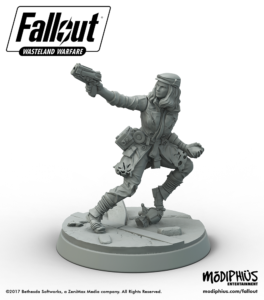
Leaders
Units can be equipped with different weapons, gear and (as we saw in the previous development blog) some can be Heroic too; however, a player also has a further opportunity to give their force a bit of extra flavour via their Leader. Each player can make one single model their Leader by allocating a Leader card to it which gives some extra abilities. A player can choose what sort of Leader they want for their force – maybe they are a Hunter who is skilled at long-range shooting and improves the searching abilities of their team, or maybe they specialise in hacking, or brawling. Some Leader cards will only be useable by specific factions too.
In Fallout: Wasteland Warfare, some abilities affect any friendly model which is close-by (with the distance determined by the model’s Presence) – these are referred to as ‘Aura’ abilities. Many Leader abilities are aura abilities so the position of the Leader and those it leads is important, and a Leader can influence a side rather than just be a single model with extra abilities. Also, Leaders can add extra diversity for players both using the same faction.
Remember, if you’re interested in receiving news on the game, sign-up for the official updates from Modiphius. Plus, you can visit the Modiphius site to check out all the great-looking models and their status.
More news to come and I’m looking forwards to sharing more details,
James.
Please note that due to the amount of spam comments bots try and post, all comments have to be manually approved so there can be a time delay to your post becoming visible. It’s often quicker to post on the Modiphius Fallout Forum or Fallout: Wasteland Warfare page on BoardGameGeek.com where I or someone else can answer your questions.
Tags: Fallout, Fallout: Wasteland Warfare, Modiphius Entertainment
Posted in Board Games, Fallout: Wasteland Warfare, Game Development | No Comments »


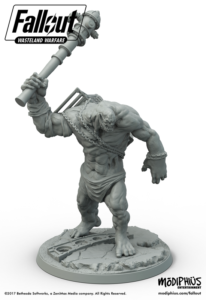
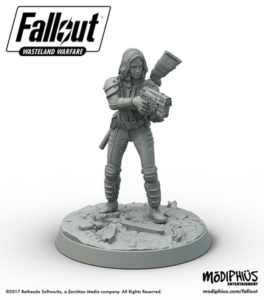 The Accuracy dice primarily improve your chances of the Skill dice being a success. Many sides of the Accuracy dice have a number which improve the Skill dice. If your skill roll needs to be 3 or less then you would succeed if your Skill dice was a 5 and you rolled -2 on an Accuracy dice as that would bring it down to 3 which is a success – you just combine what you see.
The Accuracy dice primarily improve your chances of the Skill dice being a success. Many sides of the Accuracy dice have a number which improve the Skill dice. If your skill roll needs to be 3 or less then you would succeed if your Skill dice was a 5 and you rolled -2 on an Accuracy dice as that would bring it down to 3 which is a success – you just combine what you see.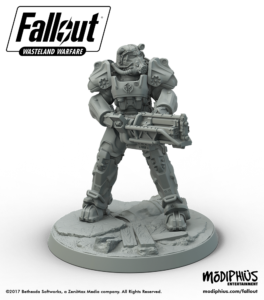 The d20 in Fallout: Wasteland Warfare allows us to have the range of 1-10 numbers but the number of available faces means we can have several 1s – so that a skill of 1 actually has a 25% chance of success – as well as some X results (which always fail) – so a skill of 10 will always have a maximum 85% chance. This system makes the full range of stat numbers useful, whilst each additional point in the stat still gives more chance of success. Also, the adjusted skill value can not go lower than 1 so a model with a relevant skill always has a chance.
The d20 in Fallout: Wasteland Warfare allows us to have the range of 1-10 numbers but the number of available faces means we can have several 1s – so that a skill of 1 actually has a 25% chance of success – as well as some X results (which always fail) – so a skill of 10 will always have a maximum 85% chance. This system makes the full range of stat numbers useful, whilst each additional point in the stat still gives more chance of success. Also, the adjusted skill value can not go lower than 1 so a model with a relevant skill always has a chance.